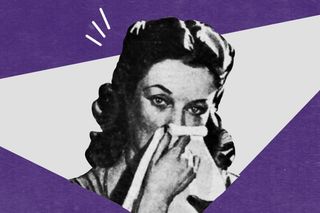
What Mucus Says About Your Health
Different colors and consistencies of mucus are indicative of various health conditions.

“Mucus is incredibly important for our bodies,” explains Michael M. Johns III, MD, director of the Emory Voice Center and assistant professor of otolaryngology-head and neck surgery at Emory University. “It is the oil in the engine. Without mucus, the engine seizes.”
In case you’ve ever wondered what purpose mucus serves, how much is too much, and why it sometimes changes color, we tried to find answers.
What is mucus?
Mucus is a protective substance released by various areas of the body such as the mouth, sinuses, throat, lungs, stomach, and intestines.
Over 90% of mucus is water, but it also comprises fat, salts, proteins, some immune cells and mucins. A mucin is a protein that gives mucus its slippery feel.
What purpose does mucus serve?
Mucus lines surfaces around the body, and acts as a protective blanket for these surfaces to prevent them from drying out. Mucus also traps unwanted substances, such as bacteria and dust, to prevent them from entering the body.
As a lubricant, mucus facilitates bodily functions — from enabling eyes to blink, or the throat to swallow, or protecting the digestive system from stomach acid. “Good” bacteria that live inside the body, and produce necessary vitamins, live in mucus.
“It’s part of your immune system, and it covers every inch of your body exposed to air that’s not protected by skin, including inside your nose,” explains Alison Grant, MD, a physician at Penn Family and Internal Medicine Cherry Hill, in a blog post.
Related on The Swaddle:
How much mucus does a body generally produce?
A healthy body can produce as much as one to 1.5 liters of mucus every day. Generally, it would take a bad cold, or allergy, to cause the body to produce more mucus than it usually does. Mucus regularly trickles down the throat without us even realizing it, but we tend to notice it when it changes in consistency or color.
What do different colors of mucus indicate about our health?
“The color of mucus comes from how it adapts to protect you, and that color can signal illness and other conditions,” explains Dr. Grant.
Producing excess clear mucus is a sign that the body may be allergic to something, and signifies that the mucus is trying to expel dust, pollen and other irritating particles.
White mucus is a sign that the body is preparing to deal with viruses that have entered through the nose and have settled behind the forehead, cheeks and nose, known as the sinuses.
Green or yellow mucus is usually one of the first signs of a cold. “White blood cells rush to battle infection, and when they’ve done their job, they get flushed out of the body along with the virus,” explains Dr. Grant. The yellow color is indicative of dead white blood cells, which may turn green if there is an excess of white blood cells.
Red or pink mucus usually signifies the presence of blood due to an injury or as a result of continuous blowing or rubbing the nose. It is also possible that the blood sticks around in the nasal cavity, so lingering blood may come out as a lighter shade of pink.
Dark mucus — shades of brown, or orange — can be due to dried blood, or the result of inhaling something brown, such as dirt or cigarette smoke. Bronchitis can also cause brown mucus.
Black mucus may be indicative of inhaling something dark, such as cigarette smoke or dust. But it may also be a sign of a fungal infection, especially in those with weaker immune systems due to diseases like cancer.
When is the right time to see a doctor about mucus?
If mucus changes to darker colors and occurs along with other symptoms such as difficulty breathing, dehydration, or body pain, or lasts more than 10 days, it could be a cause for concern.
How is excess mucus treated?
Usually, expectorants and decongestants help clear out the nasal cavity by reducing inflammation and curbing mucus production. If the mucus is due to an allergic reaction, antihistamines will block the production of histamines, which cause nasal tissues to swell up resulting in a runny nose. Eliminating possible allergens is one way to prevent the production of excess mucus due to allergies.
Anubhuti Matta is an associate editor with The Swaddle. When not at work, she's busy pursuing kathak, reading books on and by women in the Middle East or making dresses out of Indian prints.
Related


‘Drunkorexia,’ Or Skipping Meals After Binge Drinking, Can Cause Nutritional, Cognitive Deficits
